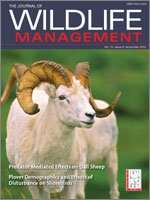In 1954 and 1955, I conducted studies on 4 beaver (Castor canadensis) colonies in Routt County, Colorado, USA, to develop a reliable and practical census method. In fall of 1955, these colonies were trapped to extirpation to obtain accurate counts and colony compositions. I established photo stations and took a series of photographs approximately every 5 years, in late September, from 1955 to 2005 to document beaver-population dynamics and beaver-pond successional changes after complete beaver removal. The number and configuration of dams, ponds, and canals remained remarkably similar, with maintenance conducted by succeeding generations of beaver. Quaking aspen (Populus tremuloides) and autumn willow (Salix serissima) boundaries also remained stable, but conifers slowly encroached. At 3 of 4 colony sites, beaver did not attempt to construct food caches for overwintering. By fall of 2005, the fourth site was also without a cache. Carrying capacity of these areas was likely limited by severe winter weather at 2,620-m to 2,900-m elevations, aspen depletion, pond-depth reduction, and sustained grazing by cattle. Although beaver carefully maintained dams, pond depths were reduced in most cases. This slow transition from an aquatic to a terrestrial system is a natural progression in this region.
How to translate text using browser tools
1 November 2010
Succession of Beaver Ponds in Colorado 50 Years After Beaver Removal
Keith G. Hay
ACCESS THE FULL ARTICLE
It is not available for individual sale.
This article is only available to subscribers.
It is not available for individual sale.
It is not available for individual sale.

Journal of Wildlife Management
Vol. 74 • No. 8
November 2010
Vol. 74 • No. 8
November 2010
beaver
Castor canadensis
colony composition
Colorado
extirpation
food cache
habitat morphology




